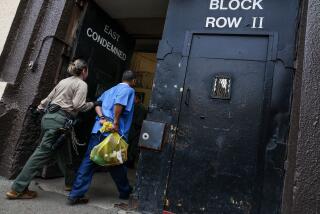A rural Northern California county had few COVID-19 cases, until an inmate transfer led to a large prison outbreak
- Share via
For months, rural Lassen County held a pandemic distinction as one of the only counties in California with zero confirmed cases of COVID-19.
The sparsely populated Northern California county, which did not report its first coronavirus case until May 22, was one of the first in the state to ease social restrictions and reopen public life.
But now, a major outbreak among inmates at a state prison in Susanville, linked to the transfer of inmates from San Quentin State Prison, has frustrated local officials who say the state’s movement of infected prisoners now poses a grave danger to their community.
“The sentiment is really of disappointment with the California Department of Corrections and Rehabilitation, to disregard the impact on our community with regard to their policy of moving inmates around,” said Richard Egan, the county spokesman.
As of Wednesday, there were 214 cases at the California Correctional Center in Susanville. There also were five confirmed cases at the adjoining High Desert State Prison.
Outside of the prisons, Lassen County has reported just 14 cases since the pandemic began. There have been no deaths and no hospitalizations, Egan said.
Local officials have struggled to get information from the state about the prison outbreak, and the county has no jurisdiction over the prison and was not consulted about the transfer, Egan said.
“It’s improving now after the horse is out of the barn, but communication has not been great,” he said.
State Sen. Brian Dahle (R-Bieber) told The Times that the California Dept. of Corrections and Rehabilitation “hasn’t been very transparent” with local leaders and that he worried about COVID-19 cases overwhelming Lassen County’s single hospital, Banner Lassen Medical Center, a 25-bed facility in Susanville.
“At this time, we should not be moving inmates around,” Dahle said. “It’s unfortunate, because our community had a very low rate of people being infected with COVID, and here we’re dealing with an outbreak. I’m frustrated. ... We were doing everything right.”
Dahle noted that the prisons are the biggest employers in Lassen County, and people drive long distances from neighboring Modoc County (the only county in California with zero reported cases) and Plumas County to go to work there. He worried that the outbreak would spread beyond prison walls and across county lines.
An estimated 60% of staff at the California Correctional Center and High Desert Prison live in Lassen County, Egan said. The rest commute from neighboring counties and across the Nevada border.
At least four prison staffers have tested positive, he said. If they reside in another county, their cases are counted among the caseloads there.
On June 8, the state transferred several inmates from San Quentin to the California Correctional Center, Egan said. Three inmates who tested negative for COVID-19 before leaving the Marin County prison were not quarantined upon their arrival in the Susanville facility and were placed among the general inmate population, Egan said.
Those inmates were tested again, and the results came back positive. The cases quickly surpassed 200. Egan said that, as far as he knows, the moving of an inmate from the California Correctional Center to the adjacent High Desert State Prison facility led to the five known cases in that prison.
In a statement to the Times, Dana Simas, a spokeswoman for the California Department of Corrections and Rehabilitation, said that on June 22, the state “restricted any movement of the incarcerated population between and throughout all institutions to essential transfers only to mitigate spread of the virus.”
About a third of San Quentin’s inmates have been infected with the coronavirus after a transfer of prisoners from a Southern California correctional facility overrun by the illness.
Unlike other prisons in California, San Quentin had escaped any coronavirus outbreak until early June. But 121 inmates were moved there on May 30 from the California Institution for Men in Chino, an early hotbed of coronavirus cases where 16 inmates have died.
The transfers ignited an outbreak at San Quentin, where 1,135 inmates have tested positive for the virus. On Monday, Marin County officials revealed that a death row inmate found dead last week in his cell had tested positive for COVID-19.
In a June 25 letter to Ralph Diaz, secretary of the state corrections department, Dahle and his wife, Republican state Assemblywoman Megan Dahle, said they had “grave concerns about the inadequate communication, planning and protocols” that led to the “explosive outbreak” at the Susanville prison.
Lassen County, they wrote, previously requested assistance from the state corrections department during the pandemic but was told that state prison staff “would not be available due to bargaining unit contract restrictions.”
The Dahles asked if the state was going to do anything to bolster the county’s “bare-bones emergency medical services capacity” and questioned why the corrections department was not participating in meetings with local health officials.
In Lassen County, health officials knew early on that the prisons were “a major risk factor” and prepared as best they could, Egan told the Times.
He said he hopes the sudden spike in cases does not cause Lassen County to be placed on the state’s coronavirus watchlist and that it does not force the county to scale back its reopening.
“Our community has done a great job at addressing the COVID issue, and we’re continuing to do that,” he said. “We’ll get through this. It’s just frustrating.”
More to Read
Sign up for Essential California
The most important California stories and recommendations in your inbox every morning.
You may occasionally receive promotional content from the Los Angeles Times.











